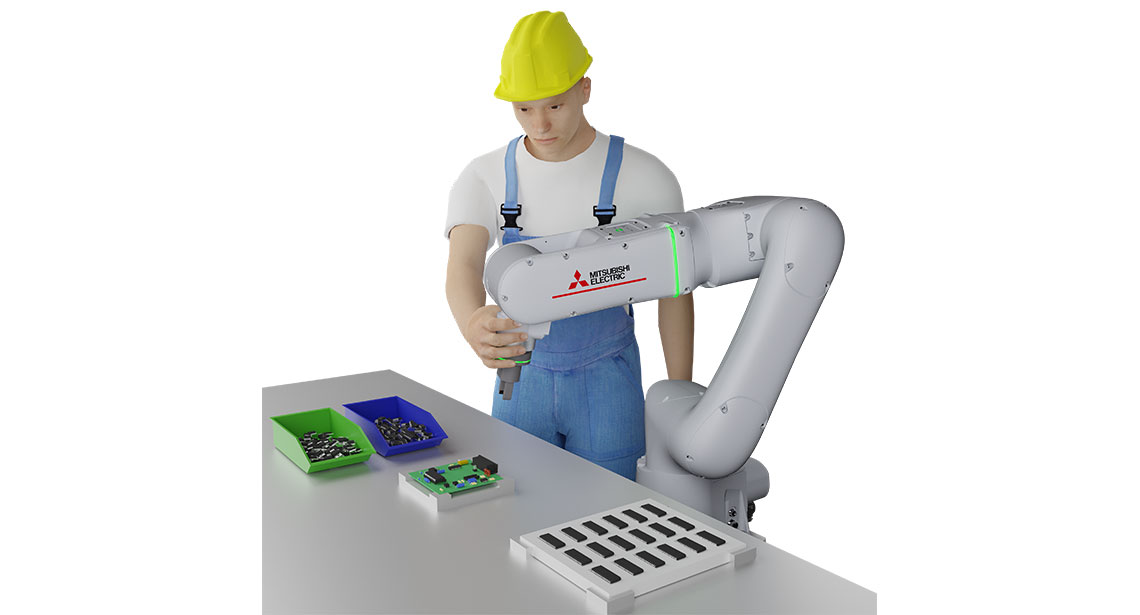With Robots becoming increasingly easier to use, and also suitable for a high number of industrial applications, they are also becoming more economical. As us humans and robots increasingly share a common space in the manufacturing environment, we are naturally giving more consideration in the choice between a collaborative or cooperative machine. Which type of robot suits your application best?
Collaborative Robots or Cobots are specially designed to implement safe human-robot collaborations such as Mitsubishi’s latest MELFA RV Series Assista articulated arm Robots. Industrial Robots, which are cooperative Robots, are equipped with safety features such as Mitsubishi’s SafePlus safety system that use proximity sensors to safeguard personnel entering the operating space. Cooperative Industrial Robots are generally associated with these applications based on these features due to their durability, high speed, payloads, accuracy and high repeatability, these are the ultimate requirements. Programming is not performed by an operator and with set routines not changing frequently, then it’s an easy decision, cooperative would be your answer.
Due to recent advances in Collaborative Robots, the lines have started to blur when it comes to applications that require the same accuracy but the payloads are lighter, the batch sizes smaller. When a Robot can be taught quickly by the operator to adapt or initiate a new routine, a better option can be Collaborative. There are many examples where a Robot may be a solution such as fine assembly work or sample transfers in biotech applications. The fact that there is now a cross over between a dedicated Cobot and an adapted Industrial Robot using a safety sensing system is relevant because the accuracy and repeatability are now comparable. Service lines are also similar which creates a new set of questions for the end-user.
When defining the task with a new set of operating parameters, the first aspect that you should consider is the ultimate automation goal that you wish to achieve. Knowing this helps you determine the type of contact between human operators and robots that are expected. Humans and Robots sometimes have to work together on a common task and in this case, the workspaces of them both overlap both spatially and chronologically to combine the advantages and strengths of both parties.
In situations like this, Cobots would provide the best option, an example being Cobots are ideal when machines need to handle and hold parts whilst a human is working on them. The ergonomics of a Cobot arm are very different from that of a human, the reach and repeatability are better, as is holding still for long periods. Using Robot assistance in this type of situation can make a task far more comfortable for a human to complete. Not only an improvement in the working environment, but it also benefits quality and productivity. Cooperative solutions would suit the application best if human operators and robots only briefly interact with each other. This may also be the case for environments where humans are not working alongside the robot but require regular access to the Robot cell, examples of this are packing, palletising, loading machine tools and filling etc.

It is also important to consider the payload and cycle time requirements, both Collaborative and Cooperative Robot systems can be used when these aspects are not relevant. Heavy components or fast processes can only be handled effectively by Cooperative Robots, however.
You also have to consider the space available for the automation equipment. Where position, speed and torque of the robot can be limited or stopped as a human approaches, it is possible to set up adjustable safety zones for Cooperative systems. This is ideal for packing station where for example, a forklift has to come in an area to remove a pallet. For assembly tasks where the operative is constantly working close to a Robot arm however, the arm would spend too long at a slow speed or be stopped. Collaborative solutions offer improved efficiency if a task requires manipulation of a low payload and is located in a compact working space.
In order to define which Robotic solutions would best address their requirements, the end-user needs to determine the level of flexibility in their automated processes. Collaborative Robots can add flexibility easily to assembly processes that need to make lots of highly individualized products in low volumes and over short batch cycles. Cooperative Robots are suited more for high volume production of items that may feature small variability. The deciding factor is very often the ROI and sometimes this can be difficult to calculate, especially on new applications with lots of variables.
Which type of robot suits your application best? If you are not sure, please get in touch and we can get you speaking with a Robot expert.

